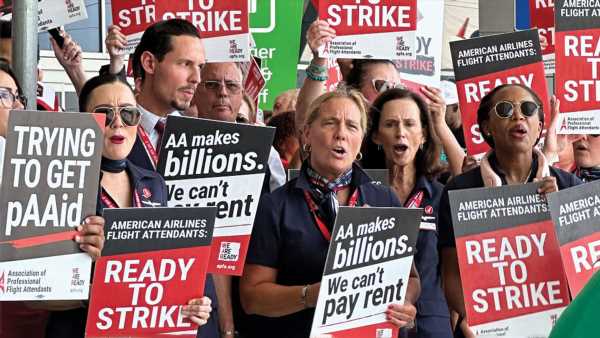
U.S. flight attendants’ unions are becoming increasingly vocal as contract negotiations linger without resolution.
The growing acrimony is taking place on the back end of a year in which U.S. airline pilots have won tens of billions of dollars in pay and benefit increases. It’s also influenced by expectations among flight attendants that they should be rewarded for their service during the pandemic and for dealing with the pandemic-time surge in unruly passenger behavior.
At Southwest, United, Alaska and American, flight attendants’ labor contracts are all up for renegotiation. The Southwest contract, the stalest of the bunch, became amendable in 2018. The American contract become amendable in 2019, which is also the last time American flight attendants received a raise, said Paul Hartshorn, national communications chair for the Association of Professional Flight Attendants (APFA) union, which represents American flight attendants.
Last month, APFA members voted nearly unanimously to authorize a strike. For now, that could be seen as just a negotiating tactic. Under the Railway Labor Act, which regulates strike actions in the airline industry, several more steps would have to play out before American flight attendants can actually walk off the job.
But Hartshorn said that if negotiations with American don’t show progress, the union could take the next formal step toward a strike, namely requesting that the National Mediation Board (NMB) grant it a release from those negotiations, as soon as the holidays.
“We’ve been given a clear mandate from our flight attendants for a contract that is industry leading, and we have a strike vote to back that up,” Hartshorn said.
Unions representing Southwest, United and Alaska have also been ratcheting up the rhetoric. (Delta flight attendants aren’t unionized.)
In June, negotiating teams representing Southwest management and the Transport Workers Union (TWU) Local 556 reached a labor agreement-in-principal, only to see it rejected by the union’s board.
More negotiations, facilitated by the NMB, were to begin again last week. In the meantime, TWU 556 is pressing its case publicly, including with a Change.org petition that has garnered more than 10,000 signatures.
“While Southwest Airlines flight attendants continue performing their important jobs to help ensure passengers’ safety and comfort in the air, they have endured too much,” reads the petition, which sites operational failures, increased passenger aggression and wages eroded by inflation, among other grievances.
Alaska Airlines flight attendants, who are represented by the Association of Flight Attendants-CWA (AFA), are also now negotiating with management through a mediator. And while United’s AFA-represented flight attendants are still in direct negotiations with the airline, they, like the flight attendants at American, Alaska and Southwest, have begun taking to the streets with informational picket lines.
The airlines’ stance
All four of those airlines provided statements emphasizing their commitment to reaching deals.
“We’re continuing to work with the Association of Flight Attendants toward an industry-leading agreement,” reads the United statement. “All United flights will operate as planned while our flight attendants exercise their right to distribute information and picket while off duty.”
Earlier this year, pilots at United, Delta and American won pay increases of between 34% and 40% over the next four years plus benefits increases and quality of life improvements. Pilots at smaller U.S. airlines have also won large pay increases amid an ongoing U.S. pilot shortage.
Hartshorn said APFA has taken note of those labor contracts. “Our wage increases should be in line with, if not more than they received,” he said.
APFA had previously called for wage increases of 47% over a three-year contract, though Hartshorn said a new offer was to be made public late last week. American was offering a 19% increase over five years, according to an APFA summary. The union is also asking for a variety of other contract improvements, including an increase from 75 to 82 in the number of paid hours its members are guaranteed monthly.
Flight attendants, though, aren’t likely to have the bargaining power of pilots, said Bloomberg Intelligence aviation industry analyst George Ferguson, in large part due to the relative speed with which new ones can be trained compared to the several years required for pilot training.
“The scarcity factor isn’t as high,” Ferguson said. “It’s going to make it harder for them to get the same gains the pilots have had.”
Flight attendants account for approximately 16% of labor costs at major U.S. airlines, he added. And with the pilot increases already in place, management will want to be careful about further cost escalations.
But Brad Beakley, CEO of the travel industry consultancy Hospitio, said that the diminished operational resilience that has afflicted airlines in the aftermath of the pandemic could play to the advantage of flight attendants. Even without receiving federal permission to strike, airline workers sometimes undertake quiet labor actions through increases in sick calls and by being less willing to accept extra shifts. Such steps can disrupt flight schedules.
“You look at the tone and the attitude right now out of the flight attendant work groups, that could be in the cards,” Beakley said. “The question is, will the airlines cave as fast as they did with the pilots.”
Source: Read Full Article









